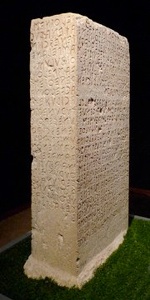
This room is dedicated to the Cippus Perusinus, a travertine boundary stone that was found in 1822 on Colle San Marco, outside Perugia. The rough finish of the lower part suggests that it was originally partly buried in the ground.
The inscription, which comprises 24 lines on the front and another 22 on the left side, is one of the longest Etruscan texts in existence. The traditional translation suggests that the inscription documents a legal contract between the two families of the Velthina (already known in Perugia) and the Afuna (from the Chiusi area) and relates to a property upon which there was a tomb belonging to the former. It contains the word “rasnes”, which refers to the Etruscan people as a whole, in a context that probably records that the agreement is made under Etruscan law. A judge named Larth Reza witnessed it, and it ends with an official formula “zichuche” (it is written).
There is more detail about it on the site of the Soprintendenza per i Beni Archeologici dell'Umbria. The full inscription (CIE 4538) and a possible translation into Italian is given in this page by Professor Massimo Pittau. The inscription is put into context in the page on Etruscan Inscriptions after 295BC.
Turn left on leaving the room, walk up the short flight of steps and turn left into
the Sala dei Bronzi.
Return to the main page on the Museo Archeologico.



